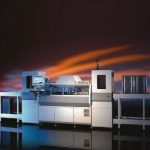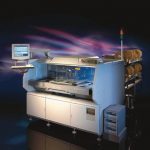Even now, more than two decades after surface-mount technology (SMT) entered the board assembly arena, the world wide total market for insertion machines is worth some _ 60m annually. Although this represents a fall of more than 79 % since the early 90s, the market is stabilizing at this level. Here we describe the sectors that are underpinning this market, taking a look at the developments that have been preserved the through hole position in both legacy and emerging assembly challenges, and examining the opportunities.
Some may believe that leaded components are dinosaurs. But there has been, and is likely to be, no extinction-level event that will see them wiped from the face of assemblies altogether. They have several key attributes that will ensure future usage. For one, the components themselves, as well as insertion machines, are relatively inexpensive compared to their SMT cousins. And because the technology is simpler, a lower skill level is required to handle the processes, which saves costs.
An overview on markets and applications
Through-hole assembly also remains big in power electronics, even though surface-mount power MOSFETs have been available for many years. This is because assemblers remain unconvinced they will get a return on the large investment involved in moving power systems assembly to SMT simply for the sake of migrating the process. But it is true that some of these applications will probably target SMT at the next significant product redesign.
On the other hand, optoelectronic packages have still not fully made the transition to SMT. This is particularly true for large LEDs, for example, which are gaining popularity in signage and vehicle lighting applications for their energy efficiency, long lifetimes, high brightness and pure colors. Growth in this sector is maintaining strong demand for insertion equipment. There are also inherent mechanical advantages to through-hole construction. Resistance to vibration and shock is greater, making through hole a reasonable option for automotive and aerospace assemblies. And finally, specialist components such as high-quality audio/analog passives including precision wire-wound resistors or high-stability capacitors will likely remain as through-hole components. Here, there is little pressure to miniaturize, and audiophiles are a notoriously conservative, highly critical and aurally discerning group.
The low-cost advantages of components and assembly technology make through-hole a safe choice for applications where low production volumes and/or low selling prices means investment in surface-mount equipment carrying significant risk. The children’s toy market is a good example, as increasingly interactive products need to incorporate large numbers of switches and buttons to activate sequences of lights, sounds, voices and actions. But uncertain sales volumes and generally low selling prices make this an extremely price-sensitive market. Toys and other commodities are experiencing great pressure on bill-of-materials and labor costs, as well as assembly costs. This is perhaps why around 60 % of insertion machine sales world wide in 2002 were destined for Asia, where relatively inexpensive material deliveries and labor maximize the advantage of through-hole simplicity.
Through-hole assembly is stable in Europe and North America too. Advanced lighting is an example, as fluorescent lighting replaces incandescent bulbs. Power-control functions including filtering, rectification and power-factor correction are migrating into the fixtures, to maximize energy efficiency in commercial, industrial, and domestic environments. TVs and white goods continue to be large application areas of the technology; particularly since these products are becoming more sophisticated in the face of unrelenting market pressure to keep prices low. As a result, Universal continues to meet orders for new insertion automation equipment at TV and white-goods assembly plants in Turkey and Poland, for example. Industrial controls, lighting and temperature controls, and some contract manufacturing, also sustain demand for through-hole assembly equipment within European territories. Europe’s automotive industry, which employs about 20 % of the entire workforce in Germany alone, is another huge market for through-hole technology. Electronic systems such as controllers for power steering, traction and transmission, LED instrument lighting and map lights, LED tail lights and other illuminations, and optoelectronic sensors for comfort and convenience applications, are finding their way into average cars in rapidly increasing numbers.
Technology drives the further automation
As we might expect, the techniques and processes involved in through-hole assembly are now very mature. Indeed, it has been more than forty-five years since Universal pioneered the technology in 1957. Competition between the diminishing number of machine vendors has resulted in speed increases, even though the market does not strictly need more speed from through-hole assembly. What has changed is the range of components that automated machines can now insert. Assemblers worldwide are always keen to eliminate hand-based assembly processes if they can be automated cost-effectively. This has driven changes in lead-frame design and other aspects of component packaging and assembly techniques, particularly in relation to radial components, to allow these to be taped and reeled for automatic assembly. Axial devices, on the other hand, have remained virtually unchanged for many years. The result of this is that, by combining the Generation-8 radial and axial insertion machines with the reconfigurable Polaris multi-purpose cell, we can automate virtually any sequence of through-hole and odd-form assembly processes.
Further refinements include replacing traditional pneumatic drives with brushless servo technology, resulting in faster, quieter and more efficient motion control. The machine platforms have also migrated to Windows-based man-machine software, a feature expected by the majority of operators and maintenance technicians. Also, by adding a TFT screen, further enhancement of the user interface is possible. Moving to Windows has also allowed improvements to multi-language support. Aside from English, status messages can now be automatically translated into a variety of other natural languages. And the enhanced font support and interpreting tools will allow all text – not only status messages – to be displayed in native languages.
These machines are already network capable; when surveyed remotely via the host controller, they form part of a seamless pool of shop-floor capacity alongside SMT and odd-form equipment. As with all Universal’s assembly automation equipment, remote diagnostics also figures prominently in ongoing development initiatives. The barriers here are not related to the through-hole performance of a machine, but rather to achieving sufficient bandwidth to support video and audio traffic over a customer network. By resolving these issues, it will be possible to observe, adjust and optimize customers’ through-hole equipment from a service desk anywhere in the world. This will allow the same level of support and warranty cover to be provided for relatively low-cost through-hole machines as for higher value SMT placement machines.
Machine selection and cost of ownership
In terms of outright speed, the vendors that continue to be active in this market have effectively reached performance parity. But before buyers turn their attention to the vendor’s customer-support infrastructure and the productivity tools on offer, two further machine-related aspects should be considered. With the contraction of the insertion equipment market, some vendors now offer fewer machine variants, probably to minimize their own inventory and build costs. But this makes it tougher for buyers to find a configuration that matches their needs at the most cost-effective price. For instance, a specific production volume and throughput requirement may imply a component capacity of, say, 20 inputs. But if the vendor’s configuration options are only 60 or 80 part inputs, the user has less choice, and must pay for considerably more capacity than is required, not to mention floor space and other expenses related to cost of ownership. Our platform allows a fine-grain approach to machine configuration at competitive costs.
This question of choice is also important when legacy equipment reaches its end of life. Users want to replace like with like; replacing stand-alone, manual-load inserters with modern automated in-line equipment imposes process changes, shop floor re-layout and additional investments that in many cases are neither commercially viable nor physically possible. But the lack of available manual-load equipment – particularly equipment that carries the CE approval now mandatory in EU countries – can force them to continue running the stoppage-prone legacy equipment instead of moving to a newer platform. Some will continue to use several older, relatively slow machines to achieve the desired throughput and insure against frequent, unplanned equipment downtime.
Universal has taken a different approach when evolving its Generation-8 family. Customers can specify a stand-alone, manual-load, CE-compliant machine that allows them to keep their current manufacturing process. This enables considerable savings by eliminating the retraining of their production staff, the expense of purchasing component magazines, and the trouble of changing the floor layout. It also requires much less floor space compared to fully automated PCB handling machines. And for low-volume, high-changeover products, the extra cost, complexity and footprint of fully automated equipment is an unwelcome penalty. Make no mistake; non pass-through insertion machines bring advantages that their owners understand very well. For example, a customer in Western Europe, who has recently taken delivery of a new CE-compliant manual-load machine, recently said that if pass-through had been the only option available, the product would have been redesigned to obsolete through-hole altogether. Clearly, manufacturers want through-hole continuance, but not at any price.
Also important is that the Generation-8 roadmap provides a provision for owners to go on using their existing inventory of work-board holders without modifications. This further streamlines the introduction of new equipment, and protects the manufacturer’s investment in tooling for especially cost-sensitive applications. The speed advantage of the latest generation also typically allows manufacturers to do the work of three to four older platforms with just one new machine.
The introduction of CE-approved manual-load axial and radial inserters also resonates beyond the EU region. Over time, multinational manufacturing businesses regularly move equipment between sites in several countries for a number of reasons, for example to save shipping costs by assembling a particular product closer to its market. It is not uncommon for a manufacturer buying equipment for a site in Brazil for instance to anticipate transferring production to an area requiring CE approval within the foreseeable future. It would not be possible to do this if the equipment to be shipped was not CE-compliant.
From a solitary peak to a reliable mesa
As the market for through-hole equipment has contracted from its peak of around _ 300m in the early 90s, most equipment vendors have exited the market. In fact, Universal is now the only Western manufacturer of through-hole equipment, and one of only two suppliers world-wide that can deliver full line and integration capabilities. Now that through-hole technique appears to have a stable, but relatively small market, emerging vendors are introducing undemanding basic machines for low-cost assembly. These are frequently based on older Universal technologies that are still more than adequate for many applications, particularly in the Far East.
The pace of change in through-hole assembly technology has slowed, and manufacturers are pleased about this. It allows them to maintain processes, factory layout, staff skill levels and investment in tooling. But customer choice remains important because manufacturers are prepared to invest in new through-hole equipment as older platforms reach their end of life. They can only do this if the price is right, and the changeover is straightforward. Nevertheless, through-hole equipment is able to make sensible advances by leveraging applicable SMT technologies, especially drives and controls, software, and productivity tools. Universal is also investing continuously as component vendors redesign though-hole devices for automated assembly.
For the equipment vendors, the through-hole business continues to be valuable, whereas Universal dominates the market in Europe by a share of around 80 %. As traditional through-hole applications such as tube-based TVs are replaced by TFT or plasma technologies-based products that make extensive use of SMT, new markets such as electronic lighting controls and optoelectronics are booming. European-based assemblers play a leading role in satisfying these trends and account for some 18 % of worldwide insertion machine sales. This being the case, electronic manufacturers can rely on ongoing availability of new insertion machines and support products, protect existing investments, while also delivering productivity enhancements.
EPP EUROPE 413
zusammenfassung
Noch immer – und sicher auch weiterhin – gibt es einen nicht zu unterschätzenden Bedarf für automatische Bestückmaschinen, die bedrahtete Bauteile einstecken. Natürlich werden weit mehr als 90 % aller Komponenten per Oberflächenmontage verbaut, aber dennoch gibt’s viele Gründe für die Verwendung von radial und axial oder anders bedrahteten Bauteilen. Aus dem geschrumpften Equipment-Markt sind Anbieter ausgeschieden, verbliebene Premium-Lieferanten wie Universal Instruments zeichnen sich auch in diesem Segment durch gezielte und anwendungsgerecht sinnvolle Innovationen aus.
résumé
Les machines automatiques à implanter les composants à fils de contact sont toujours très demandées et cette demande non négligeable persistera sans doute. Même s’il est clair que plus de 90 % des composants sont montés en surface, de nombreuses raisons existent en faveur de l’utilisation des composants à contact radial et axial ou autre. Des fabricants ont été éliminés du marché en récession de l’équipement et d’autres, comme Universal Instruments, s’illustrent dans ce segment par des innovations ciblées et intelligentes.
Ancora – e sicuramente anche in futuro – esiste un fabbisogno di macchine di connessione automatiche che lavorano componenti costruttivi cablati da non sottovalutare. Naturalmente oltre il 90 % di tutti i componenti viene montato per mezzo di procedimenti in superficie, ma ciononostante esistono molti motivi per preferire l’applicazione di componenti costruttivi cablati in senso radiale e assiale o diversamente. Molti produttori hanno abbandonato il ristretto mercato degli equipaggiamenti, mentre i rimanenti fornitori leader, quali ad esempio la Universal Instruments, sono particolarmente caratterizzati anche in questo segmento grazie a ragionevoli innovazioni mirate e appropriate all’applicazione.
Share:











